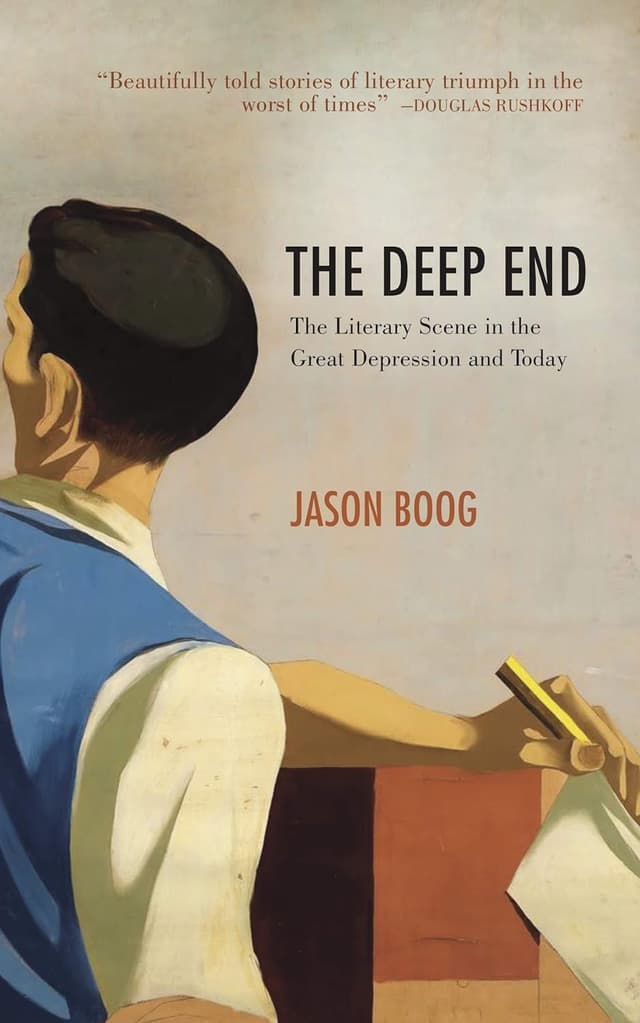Jason Boog | December 7, 2022
Google Colab Edition
On AI, code, and the magic of a supercomputer at your fingertips
Recommended Products

A book by Jason Boog, exploring the literary scene during the Great Depression and its parallels with today.
Jason Boog (JB) leads editorial at Fable, a social reading platform for book clubs. He is also the author of The Deep End: The Literary Scene in the Great Depression and Today and contributor of The New Masses Edition, The Roblox Edition, and The Shaggy Dog Edition for WITI.
Jason here. Like many 80s kids, I dreamed of interacting with supercomputers, seduced by the sleek shell of the War Operation Plan Response (WOPR) in WarGames, the towering tangle of circuitry in Superman III, and the Cobra computer banks in GI Joe. These massive machines looked truly awesome, a mix of 60s-era tape-fed mainframes with the wild exaggerations of science fiction.
Every time I logged on to my family's home computer, I always felt a bit disappointed. I just knew that in the Pentagon and Cobra Headquarters, computer specialists operated supercomputers with enough processing power to topple governments, cripple superheroes, and launch nuclear missiles. The idea of a kid like me accessing those same supercomputers was an attractive but impossible fantasy.
We are experimenting with running some weekly classifieds in WITI. If you’re interested in running an ad, you can purchase one through this form. If you buy this week, we’ll throw an extra week in for free on any ad. If you have any questions, don’t hesitate to drop a line.
Coaching for creative professionals who want deeper personal insight, a conviction in their work, and to make waves in the art world. Subscribe to Mission
Royal Braun connects cutting edge companies with key creative talent. Meet Royal Braun
Nudge, get customer insights with ease. Try Nudge
If only that kid could see me now, running Google Colaboratory (Colab, for short) on my laptop. This Google Research service lets me access computing resources far beyond anything a 1980s screenwriter could have imagined.
Why is this interesting?
For the last few years, I have been using Google Colab notebooks to run fantastical AI models that would toast my humble laptop in a few seconds. Instead of using my own processing hardware, Google Colab runs my code through Google's GPUs and TPUs. In the cloud, I can access language models like GPT-2 and text-to-image models like Stable Diffusion, experimenting with open-source AI models months before they get commercialized by corporations. A notebook is just a document stored in my Google Drive with cells for text and code. All text is written in the Markdown language and the code is written in Python. The code can be executed through my browser, allowing me to access all that additional computing power.
Max Woolf introduced me to Google Colab with his simple “Train a GPT-2 Text-Generating Model w/ GPU For Free” notebook (sadly, it doesn’t work anymore, following some updates to the platform). Using this new writing tool, Woolf outlined every step I needed to follow to use OpenAI’s GPT-2 language model to generate text. The notebook stretched the limits of my coding abilities, but I managed to generate an entire novel by following his directions.
Google Colab helps me overcome the tremendous hardware barriers of AI models, but also the wetware limits of my coding abilities. The best Google Colab notebooks have a super simple writing style that walks amateurs through complex code. I recently made my first Google Colab notebook, building an audio transcription and translation machine I can run at home.
I recommend trying two notebooks to get a feel for Colab. The Kobold community has built a super simple KoboldAI on Google Colab notebook for generating stories and text-based adventures with AI. The Stable Diffusion with Diffusers notebook gives you access to an open-source image generator that rivals OpenAI’s carefully controlled DALL·E 2.
As we stumble into this new age of computing power, it’s worth remembering the climactic battle of Superman III that traumatized thousands of kids. Even though the special effects are laughable by today’s standards, the scene channeled all our 1980s misconceptions and fears about technology as an unlucky henchwoman gets dragged into the depths of a supercomputer. Tangled in webs of silicon and circuitry, she transforms into a hideous cyborg.
That once monstrous image perfectly captures our lives now, all of us interlaced with invisible digital threads. This WITI newsletter is a Frankenstein composition of journal entries, dashed-off notes, Wikipedia entries, YouTube pages, email fragments, Google Colab notebooks, and so many other sources spread across several laptops, smartphones, and notebooks. There are supercomputers mapping your journeys, delivering your emails, serving you TikTok videos, and surveilling every one of those actions. Google Colab gives you a tiny measure of control, a way to bend these vast machines to your puny human projects. (JB)
AI Generation of the Day:
Using Stable Diffusion and Google Colab, I used AI to imagine what it would look like if Hieronymus Bosch painted a supercomputer. The results gave me a spooky vision of a new kind of Hell. (JB)
Quick Links:
Stable Diffusion is great for creating supercomputer paintings that evoke the style of long-dead Dutch painters, but it is also used to mimic hundreds of living artists' styles. Everyone needs to read Hollie Mengert’s story as they use these new tools. (JB)
Google Colab is not the only service providing computing power access. From the Machine Learning subreddit to this article, you can find plenty of discussions about alternatives. (JB)
George Saunders has a new short story collection out called Liberation Day. Every story is great, but this one in particular has become more relevant every day: “The Mom of Bold Action.” (JB)
Den of Geek took the time to break down the state of code inside Superman III. (JB)
Thanks for reading,
Noah (NRB) & Colin (CJN) & Jason (JB)

